日志
Mathematics and Informatics in Tai Chi Symbol and Hexagrams from the I Ging
|
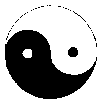
Mathematics and Informatics in Old Symbols: Tai Chi Symbol and Hexagrams from the I Ging
Klaus-D. Graf Institut für Informatik, Freie Universität Berlin D-14195 Berlin, Germany
Abstract
The paper describes how the geometric properties of the Tai Chi Symbol can be exploited in geometry education to intensify the studies on circles and to introduce some views which are different from the standard views on elementary notions such as diameter, splitting of areas or straightening, of arcs. Also, due to the philosophical background of the Tai Chi Symbol, interdisciplinary aspects as well as intercultural aspects can be integrated into mathematics education. Similar reasons can be given for teaching the hexagrams from the I Ging, in computer science education. They reveal very interesting aspects of binary coding.
Keywords
Tai Chi Symbol. Yin Yang, geometry of the circle, circular inversion. straightification of circular arcs. hexagrams, binary codinly.
The Buddhist Tai Chi Symbol (TC Symbol), also called Yin Yang Symbol, has a very strong graphical appeal. It is very often used for decoration. In modem representations the separation line is formed bv two semicircles, each having half the radius of the enclosing circle. (fig. 1). In the following we will call this line a yin yang diameter (yy diameter). Old representations are based on different construction modes as shown in figures 2 and 3.
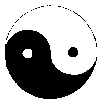
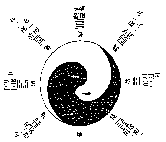
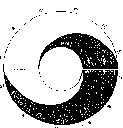
Fig.1 Fig.2 Fig.3
In the modern as well as in the old symbols you can discover mathematical symmetries which possibly give a formal background for the aesthetic appeal of the symbol. The two areas created bv the separation line. e.a., are congruent and they have a central symmetry related to the center of the circle. Their circumferences are also equal to the perimeter of the enclosing circle.
2. Different philosophies of splitting a circle
The problem of splitting the area of the circle into equal parts has been handled in art and mathematics since ancient times. I found solutions of a very high artistic standard in a temple at the old city of Nara, Japan (fig. 9) and on a door in the old German castle Wartburg (early 15th century, fig. 10). There are obvious similarities in the yin yang solution of the problem both in Japan and Germany, and there are generalizations of splittings with three, four and more areas. In European decorative arts the shape of a fishbladder is taken as a basic element of symmetry in the circle (fig. 11).
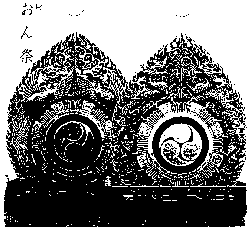

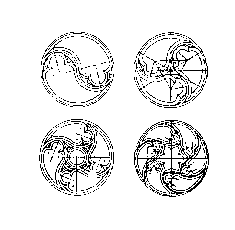
Fig.9 Fig.10 Fig.11
From the point of view of pure mathematics or geometry, the most simple way of splitting a circle into two equal parts is by using a straight diameter (see fig. 4). To get n equal areas you use n/2 diameters, if n is even. For an odd n the splitting can be done by using radii. It is well known, however, that ruler and compass can help in this construction for some n only. n has to be a product of powers of 2 and Format primes such as 3, 4, 5, 6, 8, 10, 15, 16, ... 65537. The same rules apply if yy diameters are used instead of straight diameters (fig. 6) or semicircles instead of radii.


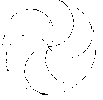
Fig.4
Fig.5 Fig.6
Using, straight lines seems to express more efficiency, using semicircles reveals more harmony in the splitting. The mode which is chosen possibly reveals an Eastern or Western philosophical attitude. Figure 12 shows how this idea is underlined by a symbol on the cover of a book about the three main philosophical streams in China, India and Europe.

Fig.12
3. Geometry of the circle in class - yy diameters
When teaching about the circle in geometry education in schools, its interactions with straight lines or sections of a line play the most important role. You look at diameters, chords, secants, tangents etc. Interactions with other circles or circular arcs are studied later
and less intensively. At the same time splitting of the area of the circle are constructed and discussed using straight lines.
Certainly one reason for this is the importance of this interaction for the solution of practical problems related to areas and circumferences, for example. From a systematic point of view the idea is close, however, to examining the interactions of circular arcs early as well and to finding out mathematical relations and properties.
The Pythagorean number PAI is a symbol for the very special relation between circular arcs and straight line sections. PAI describes the metric relation between the diameter d of a circle and its perimeter u, u = d*PAI. At the same time, for the area f of the circle we have f = (1/4)*d*d*PAI. The mathematical nature of PAI forbids the construction of a straight
section with a length equal to the perimeter of a circle using only ruler and compass. as well as the "squaring of the circle".
These relations can be described in a different way using the yy diameter of a circle. In its modern representation this splitting, line of the TC symbol is composed of two semicircles.
and it has some properties which are similar to those of the classical straight diameter. The line runs through the center of the circle, its endpoints have maximum distance on the perimeter of the circle and it has a central symmetry related to the center. The line does not. of course. generate an axial symmetry like the straight diameter.
It is obvious that the length of a yy diameter equals half of the perimeter of its circle.
Through rotation around the center we can get such yy diameters infinitely.
Naming the radius r, we have these formulae, avoiding PAI:
u = 2*t f = r*t.
These formulae are not really "practical", since t, unlike r, is not measurable with a metric ruler, but they contain something of the harmony which the splitting of a circle by a yy diameter shows, in comparison with the coolness of a straight section with a standard diameter.
Figure 7 shows that there are more lines which are composed of two semicircles and which split a circle in a wave similar to the yy diameters. Their endpoints halve the perimeter and their length equals t (=r*PAI). The diameters of the two semicircles are d' and d-d', where 0<d'<d. These "pseudo yy diameters" split the area r*t of the circle into two areas (r-r')*t and r'*t, where r'=d'/2. Of course if r'=r/2 we get the yy diameter. The circumference of the two areas is the same as the perimeter of the surrounding circle.
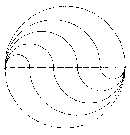
Fig.7
So we see that t (=r*PAI) is not just a term or half of the perimeter, but characterizes many circle splitting, sections which are composed of semicircles.
Choosing a sequence r' = r/n (with n natural > 1), r" = 2*r/n, etc. you get a splitting of the area of a circle with radius r in (n+l) equal areas as shown in figure 7. This method goes back to L. Collatz. This is easily seen, since if fi = i*r/n*t and f(i+1) = (i+1)*r/n*t are two of the areas generated with ri = i*r/n and r(i+l) = (i+l)*r/n, their difference is r*t/n.
This method of splitting the circle into n equal parts can be realized with ruler and compass for any natural n>l. So the pseudo yy diameters are a better means to solve the problem than standard diameters. On the other hand, we must admit that straight diameters are easier to construct for practical purposes.
Iterating the method of splitting the diameter d of a circle to get pseudo yy diameters brings you to partitions rl+r2+...+rn = r which also generate pseudo yy diameters of length t = (r*PAI). Putting- ri=r/n for all 1, with the resulting pseudo yy diameter you can approach the straight diameter as closely as you want by just choosing n large enough. The difference in length is always t - d or PAI*r-2*r, however (figure 8).
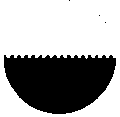
Fig.8
Another interesting generalization of the idea of the yy diameter starts with intersection a circle with a straight line and studying the arc and secant section thus generated. There is always a line similar to a yy diameter which has equal length with the arc.
4. Extension from a circle to the plane
Putting the Tai Chi Symbol on the unit circle of a complex plane and applying a reciproque complex mapplg of type z -> 1/z you extend the mathematical idea and properties of this symbol to the whole plane (figure 13). The image of a Collatz splitting is particularly fascinating (figure 16). If you change the semicircles from the yy diameters to different arcs, you get very interesting separation lines for the plane which have a strong graphical or even artistic appeal (figures 14 and 15).
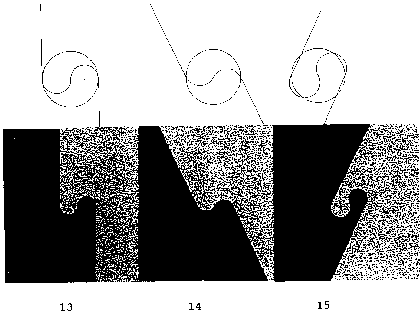
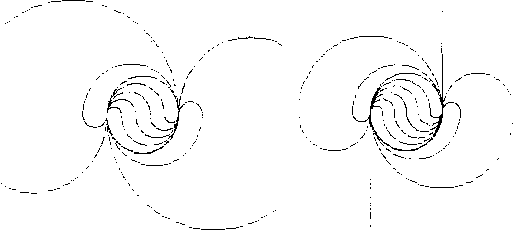
Fig.16
5. "Straightening" of the yin yang diameter and of the perimeter
Euclidean geometry knows many ways of approximating the length of a perimeter by a section of a straight line, or rather a sequence of such sections as Given by a regular polygon. Looking at Collatz' figure and its image under circular inversion, you can discover a method which gives an impression of how a semicircle is really bent towards a straight line. To discuss this method we do not need the background of the Collatz splitting and its circular inversion.
We start with a TC symbol in a unit circle with radius 1. Then t=u/2=PAI. Next we imbed the unit circle in a circle with radius 2 and perimeter 4*PAI as shown in figure 17. Now t equals one fourth of this perimeter. Next we imbed in a circle with radius 4 and t equals one eighth of its perimeter. Iterating this procedure we get a sequence of circular arcs of lengtht. which are getting "straighter and straighter". 1/4, 1/8, 1/16 etc. of a circle's perimeter can be constructed easily with ruler and compass; so we have a geometrically effective way of finding an arc of length t finally with the chord related to it coming close enough to t. This is the "straightening" of the yy diameter we started with and it is half of the "straightening" of the surrounding circle.
Mathematically this method corresponds to the method of Archimedes, who approximates the perimeter of a circle with regular polygons with numbers 4, 8, 16, 32, ... or 6, 12, 24, ... of vertices.
The hexagrams from the I Ging became public in Europe through an exchange of letters between G. W. Leibniz and the Jesuit missionary J. Bouvet, who stayed in Beijing around 1700 (figure 18). Leibniz was mostly interested in the interpretation of the hexagrams as binary numbers. From the point of view of modern informatics it is quite clear, however, that the creators of the hexagrams more than 5,000 years ago were developing a binary
coding system. The purpose was to describe and classify all phenomena of the universe growing out of Tai Chi, the universal power, by the interaction of yin and yang.
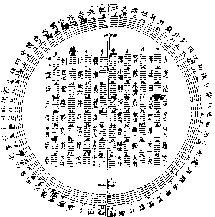
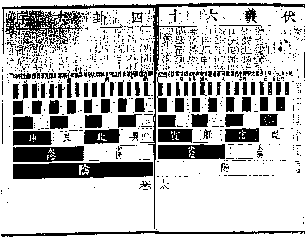
Fig.18 Fig.19
The system should also describe the changes between the phenomena, such as from winter to spring to summer to fall and so on. This is one reason why they selected orderings for the hexagrams which are different from the numerical ordering. Since the 9th century A.D. or earlier, the Chinese have known the ordering following the binary number system.
Again, for them the meaning was different. The ordering arises from a binary coding tree (figure 19) of depth 6, which "by accident" yields the binary numbers from 0 to 63 in their right order.
Another ordering clearly has combinatorial character. It starts with one hexagram without yins (0 yin), followed by six hexagrams with one yin, 15 with two yins, 20 with 3 yinsetc. Research in mathematical education at Rutgers State University in the USA (Bob Davis) has shown that many primary school children intuitively choose this way of ordering when the following problem is put to them: You have red and blue cubes.
Construct all different towers with 3 (or 4 or 5) cubes.
References
[1] Graf, K.D.: Powerful Means in Mathematics and Computer Science Education: Mathematical, Logical, Mechanical and other Roots of Computer Science in History. Jounal of the Cultural History of Mathematics, 1, Mathematics Education Society of Japan, 1991
[2] Needham, J.: Science and Civilization in China, Vol. I-IV, 1+2. Cambridge 1954-1965
[3] Zacher, H.J.: Die Hauptschriften zur Dyadik von G.W. Leibniz. Frankfurt am Main 1973
[4] Mall, Ram A. and Hiilsmann: Die drei Geburtsorte der Philosophic. Bouvier-VerIaLy. Bonn 1989

Communication with the author:
Institut für Informatik
Takustr. 9
D-14195 Berlin
Germany
FAX: ++49-30-838-75-109 e-mai: graf@inf.fu-berlin.de




